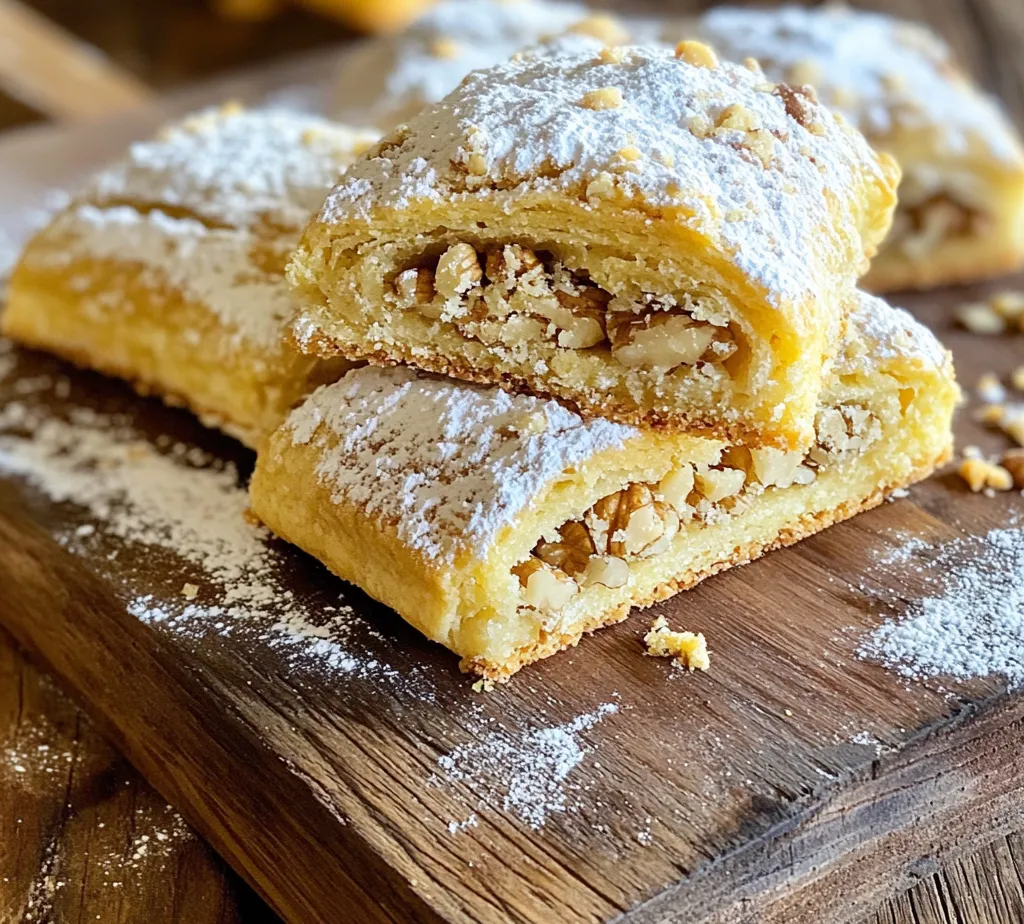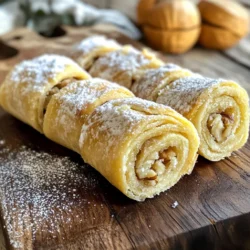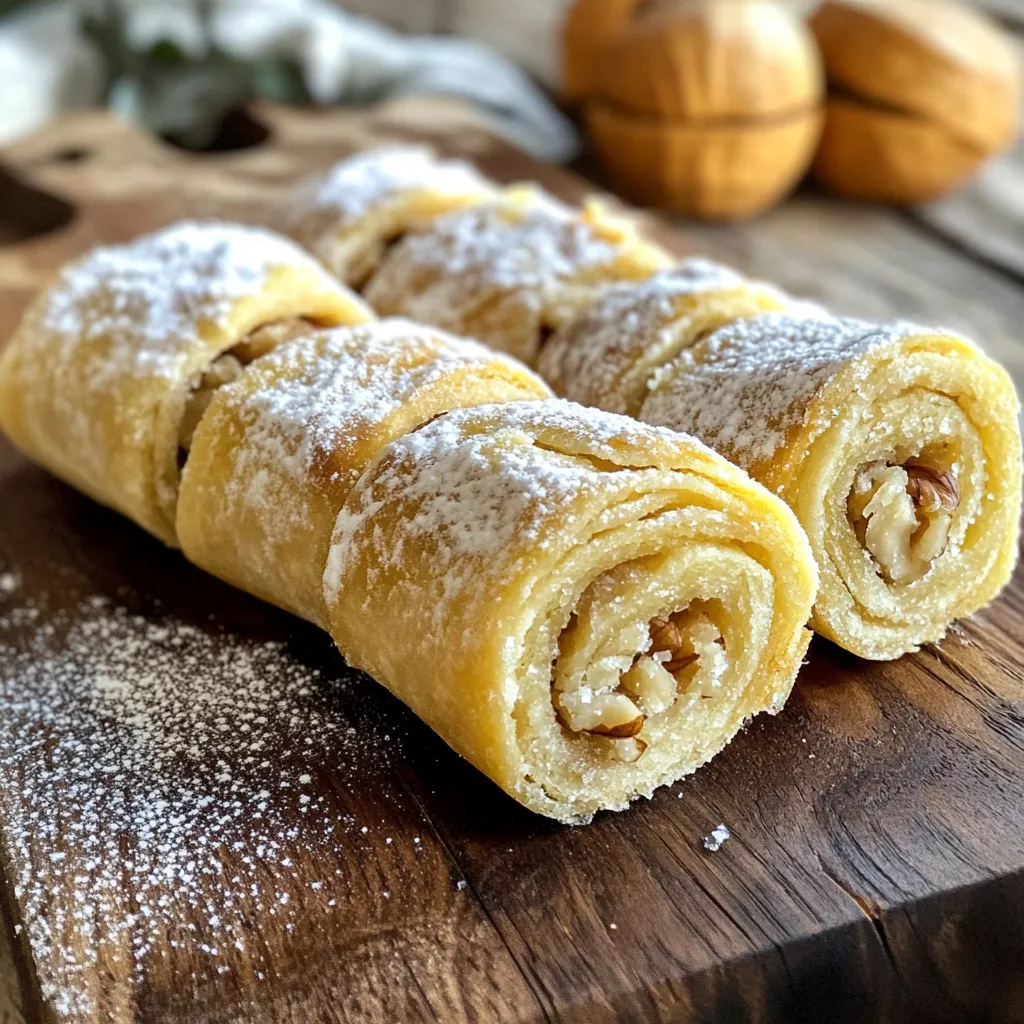Explore the enchanting world of Italian Nut Roll Cookies, a cherished recipe that brings warmth and nostalgia to any kitchen. With their delicate texture and nutty flavor, these cookies are a perfect blend of tradition and taste, ideal for festive gatherings, family celebrations, or simply indulging in a sweet treat. Italian Nut Roll Cookies, known as “Noci” in Italy, are not just a dessert; they are a slice of culinary history that represents the rich tapestry of Italian culture and family values. This article will guide you through the origins of this delightful dessert, detailed instructions on how to prepare them, and tips for perfecting your batch of Italian Nut Roll Cookies.
The Cultural Significance of Italian Nut Roll Cookies
Understanding the roots of this recipe offers a deeper appreciation for its flavors and preparation. Italian Nut Roll Cookies have a storied history that reflects the traditions and values of Italian families.
Historical Background of Nut Roll Cookies in Italian Cuisine
Nut Roll Cookies can trace their origins back to the regions of Italy, where baking has always been an integral part of family life. Traditionally made during the holidays, these cookies are often passed down through generations, with each family adding their unique touch. The use of nuts in baking is particularly significant, as they symbolize abundance and prosperity—qualities that are especially cherished during festive seasons such as Christmas and Easter.
Regional Variations and Their Unique Twists
While the base recipe for Nut Roll Cookies remains consistent, various regions in Italy have developed their own versions. For instance, in the northern regions, bakers might incorporate hazelnuts or add a hint of chocolate to the filling. In contrast, southern Italian variations might include citrus zest or even a splash of liqueur for added depth of flavor. These regional adaptations highlight the creativity and diversity within Italian baking traditions, making each batch of Nut Roll Cookies a unique experience.
The Role of Cookies in Italian Celebrations and Family Traditions
In Italian culture, cookies play a significant role in celebrations and family gatherings. They are often prepared in large quantities to share with friends and relatives during holidays or special events. The act of baking together as a family fosters a sense of unity and continuity, as recipes are shared, stories are told, and memories are created. Italian Nut Roll Cookies, with their rich flavor and comforting aroma, evoke feelings of nostalgia and love, making them an essential part of many Italian households.
Ingredients Breakdown for Italian Nut Roll Cookies
A closer look at the essential ingredients and their significance in achieving the perfect cookie is crucial for understanding how to create this delightful treat.
All-Purpose Flour: The Foundation of the Cookie
All-purpose flour is the primary ingredient in Italian Nut Roll Cookies, providing the structure necessary for the dough. Its balanced protein content allows the cookies to hold their shape while remaining tender. When measuring flour, it’s important to spoon it into the measuring cup and level it off to avoid packing, which can lead to dense cookies.
Unsalted Butter: Importance of Fat in Baking
Unsalted butter is crucial for adding richness and flavor to the cookies. The fat content in butter not only enhances the taste but also contributes to the cookies’ tender texture. Using unsalted butter allows for better control over the salt content in the recipe, ensuring a well-balanced flavor profile.
Granulated Sugar: Balancing Sweetness and Texture
Granulated sugar serves two primary purposes in the cookie dough: it sweetens and helps create a desirable texture. Sugar contributes to the cookies’ spread during baking, helping them achieve that perfect balance between crispy edges and a soft center. For those who prefer a less sweet cookie, adjusting the sugar quantity is an option, though it may affect the texture.
Eggs: Binding Agent and Moisture Provider
Eggs are essential for binding the ingredients together and providing moisture to the dough. They also contribute to the cookies’ leavening, resulting in a light and airy texture. When using eggs in baking, it’s typically best to use large eggs at room temperature to ensure even mixing and proper incorporation into the dough.
Flavor Extracts: The Role of Vanilla and Almond Extracts
Flavor extracts are key to enhancing the overall taste of Italian Nut Roll Cookies. Vanilla extract provides a warm, sweet undertone, while almond extract adds a distinct nutty flavor that complements the ground walnuts in the filling. The combination of these extracts creates a harmonious flavor profile that makes the cookies irresistible.
Baking Powder: Leavening Agent for a Light Texture
Baking powder is a leavening agent that helps the cookies rise and achieve a light texture. It works by releasing carbon dioxide when mixed with moisture and heat, which creates air pockets in the dough. Properly measuring the baking powder is important; too much can cause the cookies to rise too quickly and then collapse, while too little may lead to dense, flat cookies.
Ground Walnuts: Nutty Flavor and Nutritional Benefits
Ground walnuts are the star ingredient in the filling of Italian Nut Roll Cookies. They provide a rich, nutty flavor and a delightful crunch that elevates the overall eating experience. Additionally, walnuts are packed with healthy fats, protein, and antioxidants, making them a nutritious addition to this sweet treat.
Milk: Adjusting Dough Consistency
Milk is used in the dough to achieve the right consistency. It helps to moisten the mixture, ensuring that the dough is pliable and easy to work with. The amount of milk can be adjusted based on the humidity levels and the flour’s absorbency, so it’s best to add it gradually until the desired consistency is reached.
Powdered Sugar: The Finishing Touch for Presentation
Powdered sugar is often used to dust the finished Italian Nut Roll Cookies. It adds a touch of sweetness and enhances the visual appeal of the cookies, creating a beautiful contrast against the golden-brown exterior. For an elegant presentation, consider sifting the powdered sugar over the cookies just before serving.
Step-by-Step Guide to Making Italian Nut Roll Cookies
Mastering the preparation and baking process to create delicious cookies requires careful attention to detail and a step-by-step approach. Below are the initial steps to get you started on your journey to baking the perfect Italian Nut Roll Cookies.
Step 1: Gather Your Ingredients and Equipment
Before you begin, ensure you have all the necessary ingredients measured and ready to go. This will streamline the process and prevent any delays. Additionally, gather the equipment you’ll need, including:
– Mixing bowls
– Measuring cups and spoons
– A rolling pin
– A baking sheet lined with parchment paper
– A sharp knife or bench scraper for cutting the dough
Step 2: Prepare the Dough
1. In a large mixing bowl, cream together the unsalted butter and granulated sugar until light and fluffy. This process incorporates air into the mixture, resulting in a lighter cookie.
2. Add the eggs, one at a time, mixing well after each addition. This ensures that the eggs are fully incorporated into the dough.
3. Stir in the vanilla and almond extracts, allowing their flavors to meld with the other ingredients.
4. In a separate bowl, whisk together the all-purpose flour, baking powder, and a pinch of salt. Gradually add this dry mixture to the wet ingredients, mixing until just combined. Be careful not to overmix, as this can result in tough cookies.
5. If the dough feels too dry, add milk a tablespoon at a time until it reaches a soft, pliable consistency.
Step 3: Chill the Dough
Once the dough is prepared, wrap it in plastic wrap and refrigerate for at least 30 minutes. Chilling the dough helps to firm it up, making it easier to roll out and shape. It also allows the flavors to develop, resulting in a more flavorful cookie.
Step 4: Prepare the Nut Filling
While the dough chills, prepare the filling:
1. In a medium bowl, combine the ground walnuts, granulated sugar, and any additional flavorings you wish to include, such as cinnamon or cocoa powder for a twist.
2. Mix until well combined. If the mixture seems too dry, consider adding a splash of milk or a little melted butter to help it hold together.
Step 5: Roll Out the Dough
After chilling, remove the dough from the refrigerator and divide it into manageable portions. On a lightly floured surface, roll out one portion of the dough into a rectangle about 1/8-inch thick. The thickness can be adjusted depending on your preference, but keep in mind that thicker dough may require longer baking time.
Step 6: Assemble the Cookies
1. Spread a generous layer of the nut filling over the rolled-out dough, leaving a small border around the edges. This will allow the filling to stay contained during baking.
2. Starting from one edge, carefully roll the dough into a log shape, making sure to keep the filling intact. Pinch the ends to seal the roll.
3. Repeat this process with the remaining dough and filling until all the ingredients are used.
Step 7: Slice and Bake
1. Preheat your oven to 350°F (175°C) while you prepare the cookies for baking.
2. Using a sharp knife, slice the rolled cookies into 1-inch thick pieces. Place them cut-side down on a baking sheet lined with parchment paper, leaving space between each cookie to allow for spreading.
3. Bake in the preheated oven for 15-18 minutes, or until the cookies are lightly golden on the edges.
With these steps, you’re well on your way to creating a batch of delicious Italian Nut Roll Cookies that will delight your family and friends. As the kitchen fills with the enticing aroma of baking cookies, the anticipation of enjoying these timeless treats will surely grow. Stay tuned for more tips and tricks that will elevate your cookie-baking experience!

Preparing the Dough: Techniques for Creaming Butter and Sugar
The first step in creating the perfect Italian Nut Roll Cookies is preparing the dough, which begins with the creaming process. This crucial technique involves mixing softened butter and sugar until they become light and fluffy. The key is to use room-temperature butter, as it incorporates air more effectively.
Start by placing the butter in a large mixing bowl. Using an electric mixer on medium speed, beat the butter for about 1-2 minutes until it becomes creamy. Gradually add the granulated sugar, continuing to beat until the mixture is pale and fluffy—this usually takes around 3-4 minutes. The final result should be a light, airy mixture that will lead to tender cookies.
Incorporating Wet Ingredients: Achieving the Right Consistency
Once you have perfectly creamed the butter and sugar, it’s time to incorporate the wet ingredients. Typically, you will add eggs and vanilla extract to the mixture. Eggs not only provide moisture but also act as a binding agent, while vanilla extract enhances the flavor of your cookies.
Add one egg at a time, mixing until fully incorporated before adding the next. This step is essential for achieving a consistent mixture. After incorporating the eggs, pour in the vanilla extract and mix briefly. The dough should now be smooth and slightly glossy, indicating you have achieved the right consistency.
Mixing Dry Ingredients: Importance of Proper Blending
Before combining the wet and dry ingredients, you need to prepare your dry mix. This usually includes all-purpose flour, baking powder, and a pinch of salt. It’s essential to sift the dry ingredients together before adding them to the wet mixture. Sifting helps to aerate the flour and removes any lumps, ensuring a uniform texture in your cookies.
Once sifted, gradually add the dry mixture to the wet ingredients. Use a spatula or wooden spoon to gently fold the flour into the batter. Be careful not to over-mix; you want just enough blending to ensure there are no visible streaks of flour. Over-mixing can lead to tough cookies, so stop as soon as everything is combined.
Folding in Nuts: Ensuring an Even Distribution
The star of Italian Nut Roll Cookies is undoubtedly the nuts, which add a wonderful crunch and flavor. Traditionally, walnuts or hazelnuts are used, but you can customize this step based on your preference.
To fold in the nuts, use a spatula to gently mix them into the dough. This step is crucial as it ensures that the nuts are evenly distributed throughout the cookie dough. Aim for a consistent distribution, so each bite is packed with nutty goodness.
Chilling the Dough: Why It’s Crucial to the Final Texture
Chilling the dough before rolling and cutting is a vital step that should not be overlooked. Refrigerating the dough for at least 1-2 hours allows the butter to solidify, which helps prevent the cookies from spreading too much during baking.
Wrap the dough in plastic wrap or place it in an airtight container and refrigerate. This chilling time also enhances the flavors in the dough as they meld together, resulting in a richer taste.
Rolling and Cutting: Tips for Uniform Shapes and Sizes
Once the dough has chilled, it’s time to roll it out. Dust your work surface with a little flour to prevent sticking. Divide the dough into manageable portions, keeping the rest refrigerated while you work.
Roll out each portion to about 1/8-inch thickness, and use a sharp knife or cookie cutter to cut the dough into uniform shapes. If you prefer traditional rolls, cut the dough into rectangles that can be filled and rolled up. Aim for consistent shapes so that they bake evenly.
Filling the Cookies: Creative Ideas for Fillings
The filling is where you can truly get creative with your Italian Nut Roll Cookies. The classic filling consists of finely chopped nuts mixed with sugar and spices, but you can also explore various options.
Consider using homemade or store-bought jams or preserves, which add a delightful sweetness and fruity flavor. Apricot, raspberry, or fig jam pairs beautifully with the nutty dough. Alternatively, you can create a chocolate filling by mixing cocoa powder and chopped chocolate with the nuts for a rich twist.
Baking: Optimal Conditions for Perfect Cookies
Now that your cookies are filled and shaped, it’s time for baking. Preheat your oven to 350°F (175°C) and line a baking sheet with parchment paper to prevent sticking.
Place the cookies on the prepared baking sheet, ensuring they are spaced apart to allow for even baking. Bake for 12-15 minutes or until the edges are lightly golden. Keep an eye on them, as baking times can vary depending on your oven.
Cooling and Dusting: Presentation for Serving
After baking, remove the cookies from the oven and allow them to cool on the baking sheet for about 5 minutes before transferring them to a wire rack. This cooling period helps the cookies firm up, making them easier to handle.
Once they are completely cooled, dust the cookies with powdered sugar for a beautiful, delicate finish. This not only adds visual appeal but also provides a sweet contrast to the nutty flavors.
Flavor Variations and Customization
Exploring ways to personalize your Italian Nut Roll Cookies is a delightful part of the baking process. While maintaining their classic essence, consider the following variations:
Alternative Nuts and Fillings: Creative Substitutions
While walnuts and hazelnuts are traditional, feel free to experiment with other nuts. Pecans, almonds, or pistachios can bring unique flavor profiles to your cookies. You can also mix different nuts for added texture and taste.
Using Jams or Preserves: Enhancing Flavor Profiles
As mentioned earlier, jams and preserves can elevate the flavor of your cookies. Try out different combinations—strawberry jam with almond, or cherry preserves with hazelnuts. These fruit flavors can add a refreshing twist to your cookies.
Adapting the Dough for Dietary Preferences: Gluten-Free or Vegan Options
If you or someone you know has dietary restrictions, you can adapt the Italian Nut Roll Cookies accordingly. For a gluten-free version, substitute regular all-purpose flour with a gluten-free flour blend. Ensure that the other ingredients, like baking powder, are gluten-free as well.
For a vegan option, replace the eggs with flaxseed meal mixed with water or applesauce. Use vegan butter instead of regular butter to maintain the dough’s integrity. With these adaptations, everyone can enjoy these delicious cookies.
Storage and Shelf Life of Italian Nut Roll Cookies
Understanding how to properly store your cookies is essential for maintaining their freshness and flavor.
Best Practices for Storing Cookies
After your cookies have cooled and dusted with powdered sugar, store them in an airtight container. Layer the cookies with parchment paper to prevent them from sticking together. Keep the container in a cool, dry place, away from direct sunlight.
Freezing Options: How to Freeze and Thaw Cookies Effectively
If you want to extend the shelf life of your Italian Nut Roll Cookies, consider freezing them. Place the cookies in a single layer on a baking sheet and freeze until solid. Once frozen, transfer them to an airtight container or freezer bag, separating layers with parchment paper.
When you’re ready to enjoy them, simply thaw at room temperature for a few hours. You can also reheat them in the oven for a few minutes to restore their fresh-baked flavor.
Shelf Life: How Long Can You Enjoy Your Cookies?
When stored properly, Italian Nut Roll Cookies can last up to a week at room temperature. If frozen, they can maintain their quality for up to three months. However, for the best taste and texture, it’s recommended to consume them within a month after freezing.
Conclusion: The Joy of Sharing Italian Nut Roll Cookies
The Italian Nut Roll Cookie recipe is more than just a dessert; it’s an experience that brings people together. Whether you’re making them for a special occasion or simply to enjoy at home, these cookies embody a sense of tradition and love.
Embrace the process of baking, savor the delightful flavors, and share the joy of Italian Nut Roll Cookies with those you cherish. Each bite represents not just a delightful treat, but a connection to culinary heritage and the joy of sharing homemade goodness. Enjoy the rich flavors, the satisfying crunch of nuts, and the sweetness of your chosen fillings. You’ll find that these cookies are not just a recipe but a cherished tradition to be passed down through generations.


